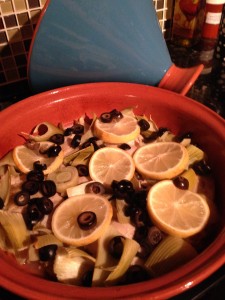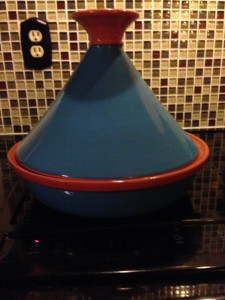 A tagine pot is traditionally used in Moroccan cooking. This two piece earthenware vessel consists of a shallow bowl and a dome shaped lid made from glazed clay. Moisture condenses in the conical section of the lid and drips back into the food. Condensation greatly reduces the amount of liquid required to turn out tender and succulent meats and vegetables. Since the tagine was traditionally used in desert climates where water was oftentimes scarce, the ability to collect and recycle excess moisture was considered a plus. The dual use of the shallow base as both cooking and serving dish suited the needs of the nomadic tribes as well.
A tagine pot is traditionally used in Moroccan cooking. This two piece earthenware vessel consists of a shallow bowl and a dome shaped lid made from glazed clay. Moisture condenses in the conical section of the lid and drips back into the food. Condensation greatly reduces the amount of liquid required to turn out tender and succulent meats and vegetables. Since the tagine was traditionally used in desert climates where water was oftentimes scarce, the ability to collect and recycle excess moisture was considered a plus. The dual use of the shallow base as both cooking and serving dish suited the needs of the nomadic tribes as well.
The word tajin is Persian in origin and refers both to the style of pot as well as the cooking method. Traditional tajin cooking is done slowly over coal. Meats, (usually lamb) fruits and vegetables combined with a variety of Moroccan spices are simmered slowly resulting in a rich savory stew.
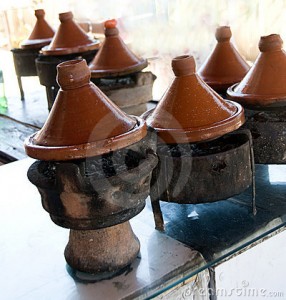 Modern day tagines are constructed using an assortment of materials from clay, ceramic glazed to cast iron. Each vessel comes with specific manufactures advice and when followed are well suited to contemporary cooking methods.
Modern day tagines are constructed using an assortment of materials from clay, ceramic glazed to cast iron. Each vessel comes with specific manufactures advice and when followed are well suited to contemporary cooking methods.
My tagine is clay with a ceramic glaze from Le Souk Ceramique. http://lesoukceramique.com/. It’s important to season the tagine prior to use to ensure the safety of both food and to prevent the pot from cracking. With a bit of preparation and care, your tagine will quickly become a favored cooking method for many years to come.
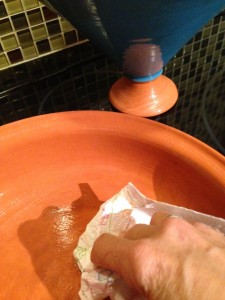 How to Season a Tagine
How to Season a Tagine
1.
Soak the base and lid in water overnight.
2.
Drain the water and allow it dry completely.
3.
Rub interior of lid and base with a light film of olive oil. This is especially important in the unglazed version.
4.
Place the tagine in a cold oven and preheat to 300 degrees. Leave for two hours.
5.
Turn off oven and allow tagine to cool in oven. You may notice some cracking on the exterior ceramic glazing. This is not a problem unless you see large flaking, then call your manufacturer.
6.
Always wash your tagine by hand, dry and reapply a light coating of olive oil before putting away.
7.
Never cook on higher than 350 degrees.
If using a ceramic cooktop like I do, you must use a diffuser. These usually consists of a circular aluminum coil that diffuses the concentration of heat away from the bottom of the pot. They can be purchased a variety of cooking outlets as well as Amazon.com. However, Tagines are well suited for the gas cooktop.
Personally, I just place my tagine in the oven at 325 degrees, put on the timer for an hour and walk away untill done.
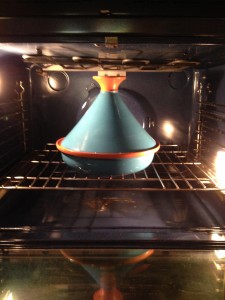 The following is one of my favorite recipes for cooking in the Tagine.
The following is one of my favorite recipes for cooking in the Tagine.
Fennel and Chicken Tagine
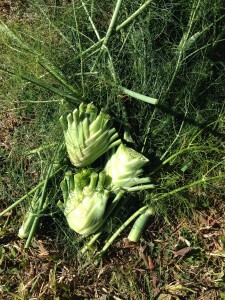 6 boneless chicken thighs. (Bone-in thighs may increase cooking time)
6 boneless chicken thighs. (Bone-in thighs may increase cooking time)
1 med onion sliced into rings.
1 lemon sliced into 6 equal rings
1 large fennel bulb, sliced or 3 small of my homegrown bulbs.
1 can sliced black olives.
½ cup chicken broth or stock
¼ cup white wine (optional).
4 to 6 saffron threads.
1 tsp. fennel seed.
¼ tsp. each; cumin, turmeric and coriander. I using fresh coriander reserve 3 Tbsp. for garnish.
Salt and freshly ground pepper to taste
Paprika to taste
Fennel fronds for garnish (optional)
Salt and pepper chicken thighs and lightly brown in 3 Tbsp. olive oil approximately 4 min each side. Longer if using bone-in.
Coat bottom of Tagine with olive oil. Preheat oven to 325 degrees. Remove upper rack prior to heating.
Place sliced onion in bottom of Tagine. Set browned thighs on top off onion and place a slice of lemon on top of each piece.
Place sliced fennel around chicken and sprinkle with black olives.
Stir spices into chicken broth and pour in around layered mixture.
Sprinkle in saffron threads and paprika to taste.
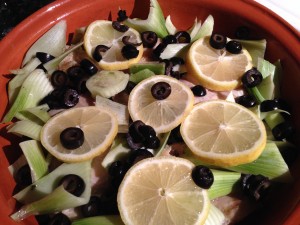 Place in oven and cook for 50 minutes. Carefully check meat after fifty minutes. If using bone-in, may require additional ¼ cup broth and longer cooking time. At this point, sprinkle with fresh coriander and or fennel fronds in final ten minutes of cook time.
Place in oven and cook for 50 minutes. Carefully check meat after fifty minutes. If using bone-in, may require additional ¼ cup broth and longer cooking time. At this point, sprinkle with fresh coriander and or fennel fronds in final ten minutes of cook time.
Remove from oven and allow to rest for 10 minutes with lid on. The dish will continue to cook so don’t overdo adding extra liquids as condensation will run down into food. It really depends on the thickness of your meat. Less is better, you can always add more. I find ½ cup broth works well with six boneless thighs.
Remove lemon slices before serving. Suggestions for sides include couscous and or jasmine rice. Enjoy!
